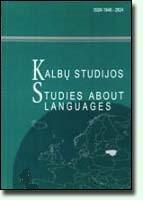Internet English: A Technically Based Mode of Language?
Internet English: A Technically Based Mode of Language?
Author(s): Goda RumšienėSubject(s): Language and Literature Studies
Published by: Kauno Technologijos Universitetas
Keywords: Internet English; affix; pattern; function; meaning
Summary/Abstract: Internet English has developed a special code and is highly affected by socio-cultural factors and the specific restrictions imposed by the technical equipment as the means of communication. As a new medium of verbal interaction it features the development of new vocabulary units. The main motifs for the development of new word forms are non- represented meaning values, irregularities, long word forms, parody and foregrounding. The created lexical units are regular grammatically and very flexible in terms of further derivation. They may contain both archaic and newly devised affixes due to alternative rules of morphology as the innovative process is based on creative analogy. Xenophobic factors, standardization trends, favour to parody, need for foregrounding and individual freedom of the participants of communication lead to the development of specific patterns of word building. Linguistic innovations distinguish the Internet community, which is built on collective beliefs; only conscious/ subconscious awareness of the strategy gives access to competent participation and introduction of language changes. Morphological elements of Internet English neologisms undergo significant influence of the sociolinguistic trends within the subculture. As a result, its specific vocabulary fits into the teleological paradigm of the culture; despite a variety of forms, the same strategy is followed by all word building processes. The paper concentrates on qualitative analysis of neologisms taking into consideration the general tendencies of the philosophy of the experienced users of Internet English. Methods and potential reasons of all types of derivation are explored. The paper concludes that despite the global scope of users and multiplicity of derivational features, specific trends may be established due to the existence of implicit universally acknowledged rules.
Journal: Kalbų Studijos
- Issue Year: 2006
- Issue No: 9
- Page Range: 56-63
- Page Count: 1

